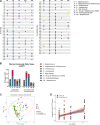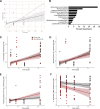Interrelated Effects of Zinc Deficiency and the Microbiome on Group B Streptococcal Vaginal Colonization
- PMID: 35943198
- PMCID: PMC9429885
- DOI: 10.1128/msphere.00264-22
Interrelated Effects of Zinc Deficiency and the Microbiome on Group B Streptococcal Vaginal Colonization
Abstract
Group B Streptococcus (GBS) in the vaginal tract is a risk factor for preterm birth and adverse pregnancy outcomes. GBS colonization is also transient in nature, which likely reflects the contributions of pathogen determinants, interactions with commensal flora, and host factors, making this environment particularly challenging to understand. Additionally, dietary zinc deficiency is a health concern on the global scale that is known to be associated with recurrent bacterial infection and increased rate of preterm birth or stillbirth. However, the impact of zinc deficiency on vaginal health has not yet been studied. Here we use a murine model to assess the role of dietary zinc on GBS burden and the impact of GBS colonization on the vaginal microbiome. We show that GBS vaginal colonization is increased in a zinc-deficient host and that the presence of GBS significantly alters the microbial community structure of the vagina. Using machine learning approaches, we show that vaginal community turnover during GBS colonization is driven by computationally predictable changes in key taxa, including several organisms not previously described in the context of the vaginal microbiota, such as Akkermansia muciniphila. We observed that A. muciniphila increases GBS vaginal persistence and, in a cohort of human vaginal microbiome samples collected throughout pregnancy, we observed an increased prevalence of codetection of GBS and A. muciniphila in patients who delivered preterm compared to those who delivered at full term. These findings reveal the importance and complexity of both host zinc availability and native microbiome to GBS vaginal persistence. IMPORTANCE The presence of group B Streptococcus (GBS) in the vaginal tract, perturbations in the vaginal microbiota, and dietary zinc deficiency are three factors that are independently known to be associated with increased risk of adverse pregnancy outcomes. Here, we developed an experimental mouse model to assess the impact of dietary zinc deficiency on GBS vaginal burden and persistence and to determine how changes in GBS colonization impact vaginal microbial structure. We have employed unique animal, in silica metabolic, and machine learning models, paired with analyses of human cohort data, to identify taxonomic biomarkers that contribute to host susceptibility to GBS vaginal persistence. Collectively, the data reported here identify that both dietary zinc deficiency and the presence of A. muciniphila could perpetuate an increased GBS burden and prolonged exposure in the vaginal tract, which potentiate the risk of invasive infection in utero and in the newborn.
Keywords: Akkermansia muciniphila; GBS; Streptococcus agalactiae; dietary zinc; group B Streptococcus; vaginal colonization; vaginal microbiome.
Conflict of interest statement
The authors declare no conflict of interest.
Figures




Similar articles
-
Interspecies Interactions within the Host: the Social Network of Group B Streptococcus.Infect Immun. 2023 Apr 18;91(4):e0044022. doi: 10.1128/iai.00440-22. Epub 2023 Mar 28. Infect Immun. 2023. PMID: 36975791 Free PMC article. Review.
-
The Group B Streptococcal Adhesin BspC Interacts with Host Cytokeratin 19 To Promote Colonization of the Female Reproductive Tract.mBio. 2022 Oct 26;13(5):e0178122. doi: 10.1128/mbio.01781-22. Epub 2022 Sep 7. mBio. 2022. PMID: 36069447 Free PMC article.
-
Diet influences community dynamics following vaginal group B streptococcus colonization.Microbiol Spectr. 2024 Jun 4;12(6):e0362323. doi: 10.1128/spectrum.03623-23. Epub 2024 May 9. Microbiol Spectr. 2024. PMID: 38722155 Free PMC article.
-
Role of MUC5B during Group B Streptococcal Vaginal Colonization.mBio. 2022 Apr 26;13(2):e0003922. doi: 10.1128/mbio.00039-22. Epub 2022 Mar 24. mBio. 2022. PMID: 35323039 Free PMC article.
-
The Double Life of Group B Streptococcus: Asymptomatic Colonizer and Potent Pathogen.J Mol Biol. 2019 Jul 26;431(16):2914-2931. doi: 10.1016/j.jmb.2019.01.035. Epub 2019 Jan 31. J Mol Biol. 2019. PMID: 30711542 Free PMC article. Review.
Cited by
-
Adaptation to zinc restriction in Streptococcus agalactiae: role of the ribosomal protein and zinc-importers regulated by AdcR.mSphere. 2024 Nov 21;9(11):e0061424. doi: 10.1128/msphere.00614-24. Epub 2024 Oct 31. mSphere. 2024. PMID: 39480081 Free PMC article.
-
Vaginal microbial dynamics and pathogen colonization in a humanized microbiota mouse model.NPJ Biofilms Microbiomes. 2023 Nov 20;9(1):87. doi: 10.1038/s41522-023-00454-9. NPJ Biofilms Microbiomes. 2023. PMID: 37985659 Free PMC article.
-
Vaginal microbiota alterations under supraphysiological estradiol state during in vitro fertilization-embryo transfer (IVF-ET) and the association with reproductive outcomes.BMC Microbiol. 2025 Aug 12;25(1):500. doi: 10.1186/s12866-025-04242-7. BMC Microbiol. 2025. PMID: 40790561 Free PMC article.
-
Influence of cervicovaginal microbiota on Chlamydia trachomatis infection dynamics.Microb Cell. 2025 Apr 15;12:93-108. doi: 10.15698/mic2025.04.848. eCollection 2025. Microb Cell. 2025. PMID: 40309355 Free PMC article. Review.
-
Interspecies Interactions within the Host: the Social Network of Group B Streptococcus.Infect Immun. 2023 Apr 18;91(4):e0044022. doi: 10.1128/iai.00440-22. Epub 2023 Mar 28. Infect Immun. 2023. PMID: 36975791 Free PMC article. Review.
References
-
- Koumans EH, Rosen J, van Dyke MK, Zell E, Phares CR, Taylor A, Loft J, Schrag S, ABC and DHAP/RTI teams . 2012. Prevention of mother-to-child transmission of infections during pregnancy: implementation of recommended interventions, United States, 2003–2004. Am J Obstet Gynecol 206:158.e1. doi:10.1016/j.ajog.2011.08.027. - DOI - PMC - PubMed
-
- Prince AL, Ma J, Kannan PS, Alvarez M, Gisslen T, Harris RA, Sweeney EL, Knox CL, Lambers DS, Jobe AH, Chougnet CA, Kallapur SG, Aagaard KM. 2016. The placental membrane microbiome is altered among subjects with spontaneous preterm birth with and without chorioamnionitis. Am J Obstet Gynecol 214:627.e1–627.e16. doi:10.1016/j.ajog.2016.01.193. - DOI - PMC - PubMed
Publication types
MeSH terms
Substances
Grants and funding
LinkOut - more resources
Full Text Sources
Medical
Molecular Biology Databases
